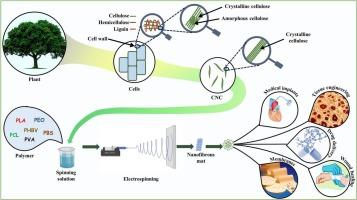Cellulose nanocrystal based electrospun nanofiber for biomedical applications–A review
IF 10.7
1区 化学
Q1 CHEMISTRY, APPLIED
引用次数: 0
Abstract
Electrospinning has become a revolutionized technique for nanofiber fabrication by offering versatile procedures to precisely regulate the nanofibers' properties suitable for a wide range of advanced applications. Nanofibers are utilized as carriers for delivering medications and other health supplements as well as their ability to discharge their contents can be easily programmed and tailored in a specific manner, while serving as tissue engineering scaffolds or medical devices. Cellulose nanocrystals (CNC) are one of the most significant natural biopolymers incorporated as reinforcing agents for nanostructured fibrous frameworks. The integration of electrospinning technology and CNC offers a viable method for manufacturing nanostructured porous substances with favorable functionality, a high ratio of surface area to volume, a tunable crystal structure along with non-toxicity and cytocompatibility, outstanding mechanical properties, flexibility, sustainability, and biodegradable properties. This article offers a thorough summary of the latest progress in the application of CNC based electrospun nanofibers in various biomedical fields such as drug delivery, tissue engineering, and wound healing. It covers the techniques and parameters used for their fabrication, the different types of raw materials employed, and their application criteria. The review concludes by discussing the prospects and challenges in this rapidly evolving research domains.

基于纤维素纳米晶的生物医学应用电纺纳米纤维--综述
电纺丝是一种革命性的纳米纤维制造技术,它提供了多种程序来精确调节纳米纤维的特性,适用于各种先进应用。纳米纤维可用作输送药物和其他保健品的载体,其内容物的排出能力可轻松编程并以特定方式定制,同时还可用作组织工程支架或医疗设备。纤维素纳米晶体(CNC)是最重要的天然生物聚合物之一,可用作纳米结构纤维框架的增强剂。电纺丝技术与 CNC 的结合为制造纳米结构多孔物质提供了一种可行的方法,这种物质具有良好的功能性、高比表面积与体积比、可调晶体结构、无毒性和细胞相容性、出色的机械性能、柔韧性、可持续性和可生物降解特性。本文全面总结了基于 CNC 的电纺纳米纤维在药物输送、组织工程和伤口愈合等多个生物医学领域应用的最新进展。文章涵盖了纳米纤维的制造技术和参数、所采用的不同类型原材料及其应用标准。综述最后讨论了这一快速发展的研究领域的前景和挑战。
本文章由计算机程序翻译,如有差异,请以英文原文为准。
求助全文
约1分钟内获得全文
求助全文
来源期刊

Carbohydrate Polymers
化学-高分子科学
CiteScore
22.40
自引率
8.00%
发文量
1286
审稿时长
47 days
期刊介绍:
Carbohydrate Polymers stands as a prominent journal in the glycoscience field, dedicated to exploring and harnessing the potential of polysaccharides with applications spanning bioenergy, bioplastics, biomaterials, biorefining, chemistry, drug delivery, food, health, nanotechnology, packaging, paper, pharmaceuticals, medicine, oil recovery, textiles, tissue engineering, wood, and various aspects of glycoscience.
The journal emphasizes the central role of well-characterized carbohydrate polymers, highlighting their significance as the primary focus rather than a peripheral topic. Each paper must prominently feature at least one named carbohydrate polymer, evident in both citation and title, with a commitment to innovative research that advances scientific knowledge.
 求助内容:
求助内容: 应助结果提醒方式:
应助结果提醒方式:


